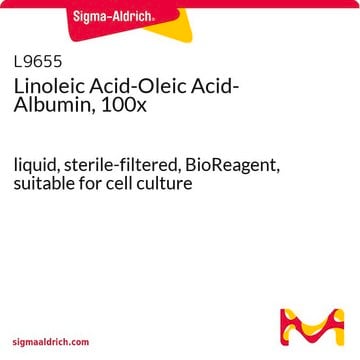O3008
Oleic Acid-Albumin from bovine serum
liquid, sterile-filtered, BioReagent, suitable for cell culture
Synonym(s):
Oleic acid-BSA complex
Sign Into View Organizational & Contract Pricing
All Photos(1)
About This Item
Recommended Products
sterility
sterile-filtered
product line
BioReagent
form
liquid
composition
Oleic acid, 2 mol/mol albumin
concentration
100 mg/mL BSA in DPBS
90-120 mg/mL protein (biuret)
technique(s)
cell culture | mammalian: suitable
impurities
endotoxin, tested
storage temp.
2-8°C
Application
Oleic Acid-Albumin from bovine serum has been used: as a component of the Dulbecco′s modified Eagle′s medium (DMEM) to study adipogenic differentiation in chicken embryonic fibroblast cell lines, to study its effects on benign prostate epithelial cells as a component of the cell culture medium to quantify triglycerides in human epithelial colorectal adenocarcinoma cells
Biochem/physiol Actions
Fatty Acid-Albumin - complexes are used as alternative sources of lipids in the development of serum-free media. Fatty acids bind to serum proteins in high proportions. Serum proteins may help in the release of beneficial fatty acids and bind those that are inhibitory. Oleic acid bound to bovine serum albumin (BSA) shows a positive effect on the growth of various cells.
related product
Product No.
Description
Pricing
Storage Class Code
10 - Combustible liquids
WGK
WGK 3
Flash Point(F)
Not applicable
Flash Point(C)
Not applicable
Personal Protective Equipment
dust mask type N95 (US), Eyeshields, Gloves
Certificates of Analysis (COA)
Search for Certificates of Analysis (COA) by entering the products Lot/Batch Number. Lot and Batch Numbers can be found on a product’s label following the words ‘Lot’ or ‘Batch’.
Already Own This Product?
Find documentation for the products that you have recently purchased in the Document Library.
Customers Also Viewed
Yinfang Wang et al.
Journal of experimental & clinical cancer research : CR, 38(1), 147-147 (2019-04-07)
Ionizing radiation (IR) therapy is the standard first-line treatment for newly diagnosed patients with glioblastoma (GBM), the most common and malignant primary brain tumor. However, the effects of IR are limited due to the aberrant radioresistance of GBM. Transcriptome analysis
Sarah Guttmann et al.
PloS one, 15(3), e0230025-e0230025 (2020-03-11)
Intestinal cells control delivery of lipids to the body by adsorption, storage and secretion. Copper (Cu) is an important trace element and has been shown to modulate lipid metabolism. Mutation of the liver Cu exporter ATP7B is the cause of
Maddalena Parafati et al.
International journal of molecular sciences, 21(24) (2020-12-19)
Non-alcoholic fatty liver disease (NAFLD) has a large impact on global health. At the onset of disease, NAFLD is characterized by hepatic steatosis defined by the accumulation of triglycerides stored as lipid droplets. Developing therapeutics against NAFLD and progression to
Timothy E Thayer et al.
Scientific reports, 10(1), 9831-9831 (2020-06-21)
Non-alcoholic fatty liver disease (NAFLD) affects over 30% of adults in the United States. Bone morphogenetic protein (BMP) signaling is known to contribute to hepatic fibrosis, but the role of BMP signaling in the development of NAFLD is unclear. In
David M Favara et al.
Metabolites, 9(12) (2019-11-30)
Adhesion G Protein-Coupled Receptor L4 (ADGRL4/ELTD1) is an endothelial cell adhesion G protein-coupled receptor (aGPCR) which regulates physiological and tumour angiogenesis, providing an attractive target for anti-cancer therapeutics. To date, ADGRL4/ELTD1's full role and mechanism of function within endothelial biology
Our team of scientists has experience in all areas of research including Life Science, Material Science, Chemical Synthesis, Chromatography, Analytical and many others.
Contact Technical Service







